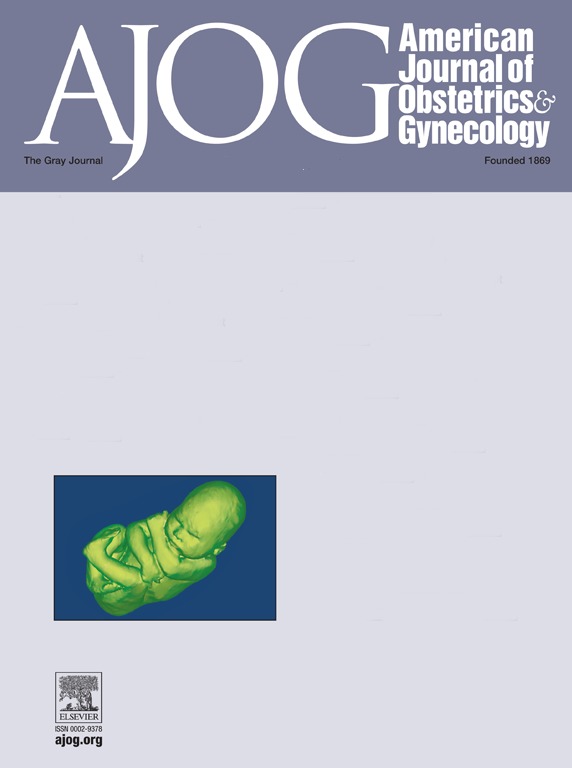Antihypertensive Treatment Adherence during Pregnancy by Race and Ethnicity.
IF 8.7
1区 医学
Q1 OBSTETRICS & GYNECOLOGY
引用次数: 0
Abstract
BACKGROUND Recent evidence from the Chronic Hypertension and Pregnancy (CHAP) trial demonstrates that treatment of even mild chronic hypertension during pregnancy reduces the risk of severe adverse maternal, fetal, and neonatal outcomes. Black patients are disproportionately affected by hypertension-related morbidity during pregnancy. Outside of pregnancy, substantial racial and ethnic differences in antihypertensive medication adherence have been reported. Insight into antihypertensive treatment adherence patterns during pregnancy may highlight approaches to decrease racial disparities in hypertension-related adverse pregnancy outcomes. OBJECTIVE To evaluate differences in antihypertensive treatment adherence during pregnancy by race and ethnicity. STUDY DESIGN Cohort study of a nationwide sample of publicly insured pregnant individuals nested in the Medicaid Analytic eXtract/Transformed Medicaid Statistical Information System Analytic Files, 2000-2018. Participants were pregnant individuals who initiated recommended antihypertensives (i.e., methyldopa, labetalol, or nifedipine) in the first half of pregnancy, with initiation defined as no antihypertensive medication dispensing during the 3 months before pregnancy. Differences in treatment adherence during pregnancy - defined as >80% of days covered in the second half of pregnancy - by race/ethnicity were evaluated. Potential confounders considered included socio-demographic characteristics, comorbidities and concomitant medication use. Risk ratios and their 95% CI were estimated using log-binomial regression; risk differences were estimated using binomial regression. Sensitivity analyses were conducted to assess the robustness of the findings. RESULTS The 16,554 hypertensive treatment initiators had a mean age of 29.4 years (standard deviation: 5.9); 7,376 (44.6%) were Black, 2,827 (17.1%) were Hispanic or Latino, 5,194 (31.4%) were White, and 1,157 (7.0%) had other/unknown race and ethnicity. The proportion of initiators with treatment adherence during the second half of pregnancy was considerably lower for individuals classified as Black (16.8%) compared to other race and ethnicity groups (range: 27.2-28.2%). After adjustment for patient characteristics, adherence to treatment was lower among Black individuals as compared to White individuals (risk ratio = 0.59 [95% CI: 0.54, 0.63]; risk difference = -9.91 [-11.71, -8.10] per 100 individuals). Treatment adherence was also lower for individuals categorized as Hispanic or Latino and other/unknown race and ethnicity compared to White individuals, but differences were less pronounced. Findings were consistent across sensitivity analyses, which included restricting the cohort to those with a recorded diagnosis of hypertension, restricting to term births, re-defining adherence as >80% days covered for any antihypertensive medication (i.e., allowing switches to antihypertensives other than methyldopa, labetalol, or nifedipine), and redefining adherence based on >50% days covered with recommended antihypertensives. CONCLUSIONS These findings suggest that adherence to antihypertensive treatment throughout pregnancy differs significantly by race and ethnicity among individuals who initiate treatment early in pregnancy. The considerably lower adherence among Black individuals is particularly concerning given that Black individuals with hypertension are at higher risk for adverse pregnancy outcomes. Defining strategies to improve adherence to antihypertensive treatment is important to reduce racial disparities in maternal morbidity.妊娠期抗高血压治疗依从性的种族和民族差异。
背景:最近来自慢性高血压与妊娠(CHAP)试验的证据表明,即使在妊娠期间治疗轻度慢性高血压,也会降低母体、胎儿和新生儿严重不良结局的风险。黑人患者在怀孕期间不成比例地受到高血压相关疾病的影响。在妊娠期以外,在抗高血压药物依从性方面存在明显的种族和民族差异。洞察妊娠期间抗高血压治疗依从性模式可能突出减少高血压相关不良妊娠结局的种族差异的方法。目的评价妊娠期抗高血压治疗依从性的种族差异。研究设计:对2000-2018年医疗补助分析提取/转化医疗补助统计信息系统分析文件中嵌套的全国公共保险孕妇样本进行队列研究。参与者是在怀孕前半段开始服用推荐的抗高血压药物(即甲基多巴、拉贝他洛尔或硝苯地平)的孕妇,开始服用的定义是在怀孕前3个月没有服用抗高血压药物。评估了不同种族/民族在怀孕期间治疗依从性的差异-定义为在怀孕后半期覆盖的80%的天数。考虑的潜在混杂因素包括社会人口统计学特征、合并症和伴随用药。使用对数二项回归估计风险比及其95% CI;使用二项回归估计风险差异。进行敏感性分析以评估研究结果的稳健性。结果16554例高血压治疗起始者的平均年龄为29.4岁(标准差为5.9);7,376人(44.6%)为黑人,2,827人(17.1%)为西班牙裔或拉丁裔,5,194人(31.4%)为白人,1,157人(7.0%)为其他/未知种族和民族。与其他种族和族裔群体(范围:27.2-28.2%)相比,黑人个体在妊娠后半期坚持治疗的启动者比例(16.8%)要低得多。调整患者特征后,黑人患者的治疗依从性低于白人患者(风险比= 0.59 [95% CI: 0.54, 0.63];风险差异=每100人-9.91[-11.71,-8.10])。与白人相比,西班牙裔或拉丁裔和其他/未知种族和民族的个体的治疗依从性也较低,但差异不太明显。敏感性分析的结果是一致的,包括将队列限制在有高血压诊断记录的人群中,限制足月分娩,将依从性重新定义为任何抗高血压药物覆盖>80%的天数(即,允许切换到甲基多巴、拉贝他洛尔或硝苯地平以外的抗高血压药物),并根据>50%的天数重新定义依从性推荐的抗高血压药物。结论:在妊娠早期开始抗高血压治疗的个体中,整个妊娠期抗高血压治疗的依从性存在明显的种族和民族差异。考虑到黑人高血压患者发生不良妊娠结局的风险较高,黑人患者的依从性明显较低尤其令人担忧。确定策略以提高抗高血压治疗的依从性对于减少孕产妇发病率的种族差异非常重要。
本文章由计算机程序翻译,如有差异,请以英文原文为准。
求助全文
约1分钟内获得全文
求助全文
来源期刊
CiteScore
15.90
自引率
7.10%
发文量
2237
审稿时长
47 days
期刊介绍:
The American Journal of Obstetrics and Gynecology, known as "The Gray Journal," covers the entire spectrum of Obstetrics and Gynecology. It aims to publish original research (clinical and translational), reviews, opinions, video clips, podcasts, and interviews that contribute to understanding health and disease and have the potential to impact the practice of women's healthcare.
Focus Areas:
Diagnosis, Treatment, Prediction, and Prevention: The journal focuses on research related to the diagnosis, treatment, prediction, and prevention of obstetrical and gynecological disorders.
Biology of Reproduction: AJOG publishes work on the biology of reproduction, including studies on reproductive physiology and mechanisms of obstetrical and gynecological diseases.
Content Types:
Original Research: Clinical and translational research articles.
Reviews: Comprehensive reviews providing insights into various aspects of obstetrics and gynecology.
Opinions: Perspectives and opinions on important topics in the field.
Multimedia Content: Video clips, podcasts, and interviews.
Peer Review Process:
All submissions undergo a rigorous peer review process to ensure quality and relevance to the field of obstetrics and gynecology.

 求助内容:
求助内容: 应助结果提醒方式:
应助结果提醒方式:


